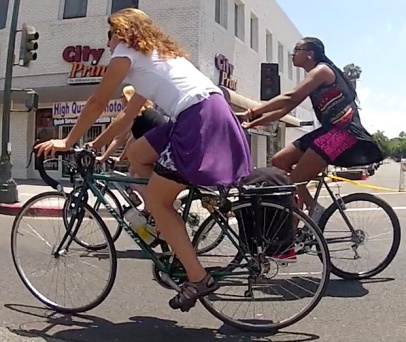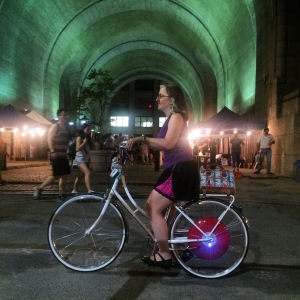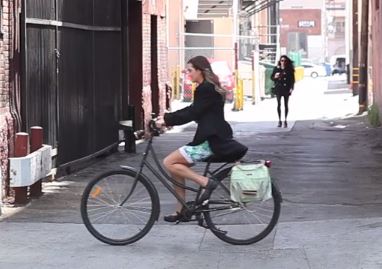 Bikie Girl recently participated in the Ride In Style Shop, a pop up shop held during Bike Week in Manhattan, and featuring eight indie brands, all providing gear to help city cyclists ride in style. To make it more fun, each brand sponsored an event. Bikie Girl provided a workshop called “Bike Commuting Made Easy”. Here’s a summary of what we covered in the commuting workshop, as well as a glimpse at the different brands featured in our shop.
Bikie Girl recently participated in the Ride In Style Shop, a pop up shop held during Bike Week in Manhattan, and featuring eight indie brands, all providing gear to help city cyclists ride in style. To make it more fun, each brand sponsored an event. Bikie Girl provided a workshop called “Bike Commuting Made Easy”. Here’s a summary of what we covered in the commuting workshop, as well as a glimpse at the different brands featured in our shop.
Getting Started: Keep It Simple
Keep it simple at first. Establish a small goal: to bike to a nearby store for an errand, or to bike home from work one day this week. You will be going through the planning and execution logistics, and perhaps overcoming some trepidation, and that is enough for the first time at it. Make sure you are ready by thinking through the following items to ensure a positive experience. If you are new to city riding, you might start out with recreational social rides led by a local bike advocacy group. Riding with a group can make city riding safer, teach you city riding skills, and introduce you to others who like to ride. It’s also a great way to discover parts of your city you never knew.

If you will ride your own bike, consider taking it to a local bike shop for a tune up and safety check. If you don’t know how to fix a flat tire, now is the time to learn and practice (you can find tutorials on youtube). The weekend before your first ride, check your ABC’s: A – air in the tires; B – brakes working properly; C – chain is clean and lubed. Re-check these before each ride. It’s normal for your tires to need a little more air, or for your chain to need some cleaning, about once a week or so. Checking these items regularly will also make it easy for you to notice when the brakes are getting worn, or another repair is needed.

If you will use bike share, go to the web site for your city’s bike share system and familiarize yourself with how it works, what you need to check out a bike, and where the docking stations are for your start and stop points. Download an app to make it easy to find bike share stations while out and about. The Spotcycle app works with most bike share systems.


If taking your own bike, you will want to carry a patch kit, extra inner tube, a pump, and bike tools, such as a multi-tool. Keep a quality lock with you, even if you can park the bike inside, as you may need it when stopping for an errand. High quality theft-resistant locks can be heavy, but TiGr offers titanium locks that are strong, light and stylish.


You are likely able to ride in whatever clothes you wear to work. Exceptions are avoiding or adjusting for long, flowy items that might get caught in the spokes, or dealing with hills, distance, or weather that leaves you too sweaty or wet. You can pin up, anchor, or tie a knot in a long, loose skirt, or use a pant clip or slap band to keep pant legs out of the way. For sweaty situations, you can bring fresh clothes with you and change at work. Some work places offer shower facilities or have a gym close by. Many bike commuters keep extra clothes at work, or bring a week’s worth to the office at a time. You can also keep a kit of toiletries at work to use for freshening up. Consider a small towel, cleansing wipes, deodorant, and a comb or brush.


Planning Your Route: Map It Out
The best route for biking to work is likely different from the route you would take by car or other means. Most cities provide a map of bike routes, bike paths, and bike-friendly streets. Google maps and other bike routing software can help you figure out a suitable route. Test ride your route on the weekend to make sure there aren’t any unpleasant surprises and to get familiar with your route when there is less traffic on the roads. Keep in mind that occasionally Google maps will direct you to cross a major street without a traffic light. If you get stuck in such a situation, consider taking the sidewalk (walk the bike if sidewalk riding is not legal in your city) to access the nearest crossing with a traffic light.
Carrying Your Stuff: No Sweat
Options for carrying your things include: a messenger bag (make sure it is stable while riding), backpack, basket or panniers. A bag that is against your back will create much more sweating, so many prefer a basket or a pannier that attaches to the rear rack. Po Campo provides a variety of stylish options that include bags that hook on your bike and can also be your professional-looking briefcase or handbag. Rear-mounted bike baskets allow for a more stable weight distribution, while front baskets provide easy access while riding. Your choice will also be influenced by what you need or will have to carry with you upon arrival. Think also about whether your arrangement will be used for shopping or carrying children.

Know your local bike laws. The most important keys to safety relate to being visible and predictable to others and being prepared for the unexpected. Ride with the flow of traffic, and take the lane when sharing the road with motorized vehicles. Riding too close to the edge of the lane makes you less visible to motorists and can encourage drivers to pass you too closely. Allow 3-5 feet between you and parked cars to avoid getting doored. Avoid weaving around parked cars, as that can catch motorists by surprise when you re-enter the traffic lane. Be aware of others traveling on foot, bike, or by car. Signal your turns, and use vocals or a bell to let others know you are approaching them to pass or to alert pedestrians. You can increase your skills and confidence by taking a class with your local bike advocacy organization. Click here to see some examples of the skills that will help you handle dicey situations that can arise on city streets.

Wear reflective clothing at night, and use a white light in front and a red light in back. Brands like Vespertine NYC provide stylish reflective vests, jackets, scarves, and dresses. Flashing lights can make it harder for others to gauge distance and are unsafe (to others) as front lights. Lights vary, so be sure you know how effective the lights you have will be. Consider also whether they will require battery replacement or can be recharged. Lights are often stolen from parked bikes, so consider lights you can easily carry with you. Alternatively, dynamo lights whose power is generated by the front wheel and integrated into the bike design are less easy to steal from a parked bike.
Multi-Modal Options: Create A Back-Up Plan
If the distance is too great, one direction is too hilly, or you feel more comfortable knowing you don’t have to ride both ways, look into the options for public transit. Some cities allow bikes on trains, buses, and/or subways, others allow them only during non-commuting hours, or have limited space. Some commuters use public transit for part of their route, or in one direction. Others take public transit (or drive) at the beginning and end of the week to carry clothes and other items for the week, and use the bike in between. These options can also be your back-up in case of weather or an equipment mishap.

And don’t be surprised if you start noticing an extra spring in your step when you arrive at the office!



2 thoughts on “Bikie Girl’s Guide to Bike Commuting”